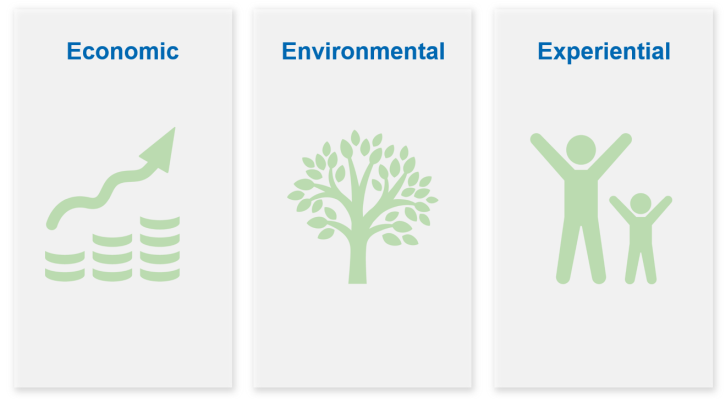The "Three E's"

Similar to the concept known as the "Triple Bottom Line," Environmental Systems Design ("ESD") has developed a comprehensive Intelligent Building solution framework that delivers results to its customers to support the "Three E’s" – Economic, Environmental and Experiential value stream.
Every new high performance, smart, intelligent, sustainable, green building that is being designed, built and operated today requires a rock-solid business case that is economically viable, environmentally sustainable and experientially successful. Investors, owners, developers, tenants, end-users and visitors alike all expect today’s buildings to be cost-effective, LEED or WELL certified and fully capable of supporting today’s digital lifestyle. To compete effectively in today’s corporate and commercial real estate markets in every market, a project must provide benefits across the spectrum of the “Three E’s. “
So…what are the “Three E’s in more detail? Let’s start with the first category – Economic performance. What are the key performance metrics of a building with superior economic attributes?
- Lower OpEx/CapEx
- Less Maintenance
- Lifespan Increase
- Asset Demand
- Valuation
- Adaptability Speed
- Competitive Advantage
- Energy Conservation
- Sustainability
- Stewardship
- Occupant Awareness
- Utility Optimization
- Grid Stress
- Green Construction
- Prestige
The most successful buildings today offer much more than just a place to work. As we have seen since the dawn of the new millennium, the work place is no longer a place to stare at your computer monitor all day and put in the hours. The highly experiential work place provides an extension of the digital lifestyle that starts at home and continues throughout the day as today’s workers experience a full range of places to work, collaborate and produce new ideas, new inventions and tomorrow’s products and services.

Today’s intelligent buildings are expected to have the latest and most cost-effective technology systems available on the market. In the commercial and corporate real estate market, it can sometimes be confusing about what systems are being provided by each party in the lease agreement.
To make things easier for the Owners, Developers, Tenants, Architects, Engineers, Contractors, Facility Managers, in fact, all the key stakeholder groups involved in the full life-cycle of the built environment, ESD has developed this checklist for those systems provided by the Landlord versus those provided by the Tenant.

This Week’s Sponsor
ESD is a leader in Improving Society Through the Built Environment. It creates solutions that produce economic, environmental and experiential benefits for its clients, many of whom are the biggest names in the worlds of business, technology - and beyond. The company is in the forefront of developing Intelligent Buildings. For more information, please visit www.esdglobal.com.
Read Next
 3/27/2025
3/27/2025
The Convergence of Edge Computing, Cloud, and AI in Building Automation and Smart Buildings In the built environment, we have seen the convergence of Operational Technology (OT) and Information Technology (IT), later expanding to include Workplace Technologies (WP).
 3/27/2025
3/27/2025
DC Power: A Holistic Approach to Energy Savings in Commercial Buildings In today's energy-conscious world, businesses constantly seek ways to reduce their carbon footprint and operational costs.
 3/13/2025
3/13/2025
How to Achieve Eco-Friendly Facility Management Commercial real estate operators and facility managers are focusing on sustainable practices to minimize environmental impact, create healthier workplaces, improve productivity and lower operational costs.
 1/23/2025
1/23/2025
When It Comes To Managing Properties’ Parking, Technology Is Key It’s easy for developers and real estate owners to think of parking as a necessary evil. They know they have to provide it (often, because it’s mandated by code), they understand that prospective tenants and buyers expect to be provided parking, but they haven’t figured out how to maximize its value.







.gif)


